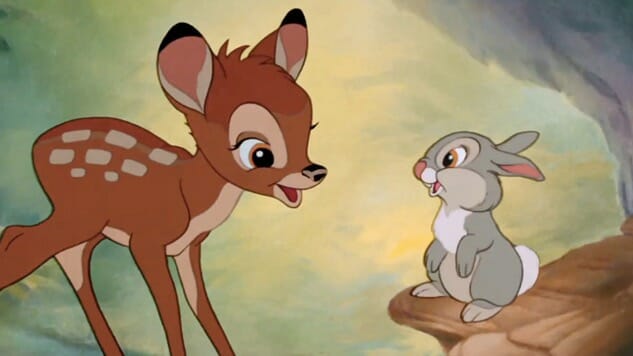deGeneration X: This Argentine Park Fleeced Bambi
Image: Courtesy of Disney Movies
The Lake District in North Patagonia is an enchanting collection of blue lakes, lush forests, tiny islands, snow-capped mountains and volcanoes that stretch between Argentina and Chile with the Andes cutting through the middle. Bariloche (Argentina) and Pucón (Chile) are prime Lake District stops that could easily double as Swiss alpine villages, but Los Arrayanes National Park on the banks of Nahuel Huapi Lake in Argentina is of particular interest to film bluffs. Per Argentina-Patagonia.com, “A small house built in the middle of the forest and the deer living in the area … were the inspiring muse of the famous Walt Disney for his cartoon Bambi,” while ForestNation.com wrote, “The forest inspired Walt Disney so much that he modeled forests in his film Bambi on the [forest of] Arrayanes.”
How could any self-respecting American skip Bambi’s Forest when already in nearby Bariloche? I had to go. I took the 80-minute bus voyage to Villa La Angostura, a tiny town nicknamed the Garden of Patagonia mere miles from Los Arrayanes National Park.
Los Arrayanes, declared a national park in 1971, is a compact forest about eight square miles in size on the Quetrihué Peninsula jetting out into Nahuel Huapi Lake. Arrayanes actually resides inside Argentina’s oldest national park, Nahuel Huapi, established in 1934, but the second designation was given to Arrayanes to further protect its gorgeous forest of rare, fragile arrayán trees. A person can easily access the park by land, but I opted to take a tourist boat 45 minutes down the Arrayanes coastline to the tip of the peninsula and then hike the eight-plus miles (with side trips) through the park back to town.
The southern tip of the peninsula contains the highest concentration of arrayán trees, a relative of the Chilean myrtle, and the forest (Bosque de Arrayanes) itself is largely made up of tall and lanky 300-year-old trees (some twice that age) stretching 40 to 50 feet into the sky, sometimes at strange angles. The arrayán produces small-yet-fragrant green leaves and white flowers that only slightly change the tree’s dominant color profile, which is a cinnamon-like orangish-brown with occasional white stripes where pieces of bark came off. A guide on the boat talked to the hikers about the park and the trees, but after we arrived at the forest, I had one more question before heading off into the woods.
“I have a quick question,” I said, stopping the guide before he got back on the boat. “Did this forest really inspire the setting for the movie Bambi?”
“No, it did not,” said the guide, followed by silence.
“I’m sorry if that was a weird question, but I asked because I read that several times before coming here, and you even have businesses in town that have the word Bambi on it.”
-

-

-

-

-

-

-

-

-

-

-

-

-

-

-

-

-

-

-

-

-

-

-

-

-

-

-

-

-

-

-

-

-

-

-

-

-

-

-

-








































